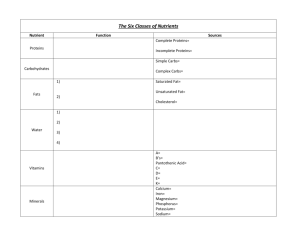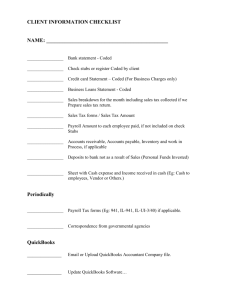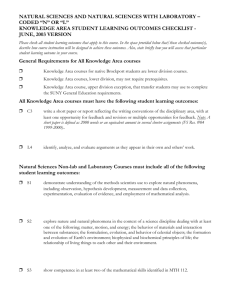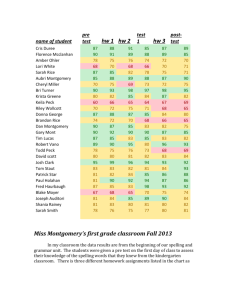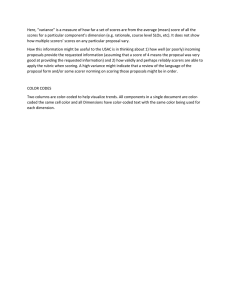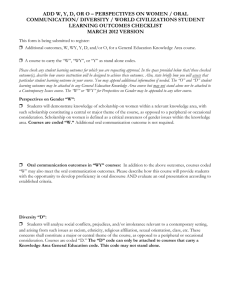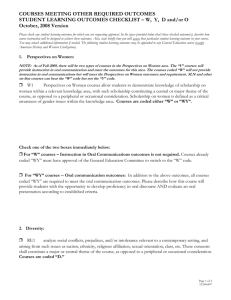Comparison of Cooperative Schemes using Joint Channel Coding and High-order Modulation
advertisement
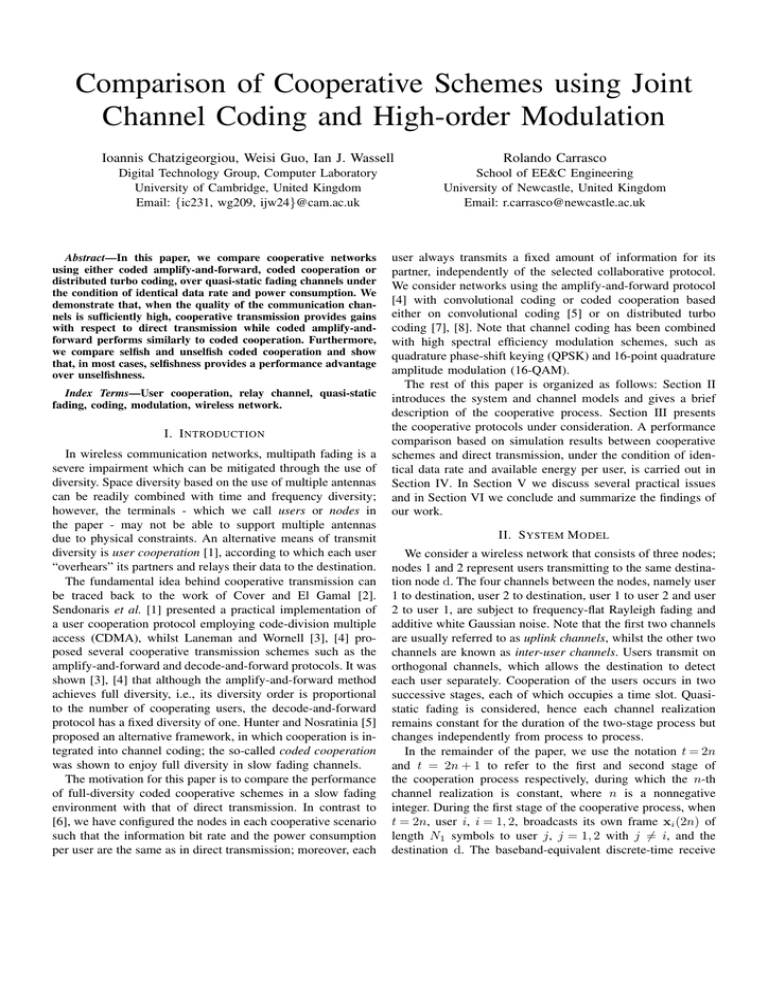
Comparison of Cooperative Schemes using Joint
Channel Coding and High-order Modulation
Ioannis Chatzigeorgiou, Weisi Guo, Ian J. Wassell
Rolando Carrasco
Digital Technology Group, Computer Laboratory
University of Cambridge, United Kingdom
Email: {ic231, wg209, ijw24}@cam.ac.uk
School of EE&C Engineering
University of Newcastle, United Kingdom
Email: r.carrasco@newcastle.ac.uk
Abstract—In this paper, we compare cooperative networks
using either coded amplify-and-forward, coded cooperation or
distributed turbo coding, over quasi-static fading channels under
the condition of identical data rate and power consumption. We
demonstrate that, when the quality of the communication channels is sufficiently high, cooperative transmission provides gains
with respect to direct transmission while coded amplify-andforward performs similarly to coded cooperation. Furthermore,
we compare selfish and unselfish coded cooperation and show
that, in most cases, selfishness provides a performance advantage
over unselfishness.
Index Terms—User cooperation, relay channel, quasi-static
fading, coding, modulation, wireless network.
I. I NTRODUCTION
In wireless communication networks, multipath fading is a
severe impairment which can be mitigated through the use of
diversity. Space diversity based on the use of multiple antennas
can be readily combined with time and frequency diversity;
however, the terminals - which we call users or nodes in
the paper - may not be able to support multiple antennas
due to physical constraints. An alternative means of transmit
diversity is user cooperation [1], according to which each user
“overhears” its partners and relays their data to the destination.
The fundamental idea behind cooperative transmission can
be traced back to the work of Cover and El Gamal [2].
Sendonaris et al. [1] presented a practical implementation of
a user cooperation protocol employing code-division multiple
access (CDMA), whilst Laneman and Wornell [3], [4] proposed several cooperative transmission schemes such as the
amplify-and-forward and decode-and-forward protocols. It was
shown [3], [4] that although the amplify-and-forward method
achieves full diversity, i.e., its diversity order is proportional
to the number of cooperating users, the decode-and-forward
protocol has a fixed diversity of one. Hunter and Nosratinia [5]
proposed an alternative framework, in which cooperation is integrated into channel coding; the so-called coded cooperation
was shown to enjoy full diversity in slow fading channels.
The motivation for this paper is to compare the performance
of full-diversity coded cooperative schemes in a slow fading
environment with that of direct transmission. In contrast to
[6], we have configured the nodes in each cooperative scenario
such that the information bit rate and the power consumption
per user are the same as in direct transmission; moreover, each
user always transmits a fixed amount of information for its
partner, independently of the selected collaborative protocol.
We consider networks using the amplify-and-forward protocol
[4] with convolutional coding or coded cooperation based
either on convolutional coding [5] or on distributed turbo
coding [7], [8]. Note that channel coding has been combined
with high spectral efficiency modulation schemes, such as
quadrature phase-shift keying (QPSK) and 16-point quadrature
amplitude modulation (16-QAM).
The rest of this paper is organized as follows: Section II
introduces the system and channel models and gives a brief
description of the cooperative process. Section III presents
the cooperative protocols under consideration. A performance
comparison based on simulation results between cooperative
schemes and direct transmission, under the condition of identical data rate and available energy per user, is carried out in
Section IV. In Section V we discuss several practical issues
and in Section VI we conclude and summarize the findings of
our work.
II. S YSTEM M ODEL
We consider a wireless network that consists of three nodes;
nodes 1 and 2 represent users transmitting to the same destination node d. The four channels between the nodes, namely user
1 to destination, user 2 to destination, user 1 to user 2 and user
2 to user 1, are subject to frequency-flat Rayleigh fading and
additive white Gaussian noise. Note that the first two channels
are usually referred to as uplink channels, whilst the other two
channels are known as inter-user channels. Users transmit on
orthogonal channels, which allows the destination to detect
each user separately. Cooperation of the users occurs in two
successive stages, each of which occupies a time slot. Quasistatic fading is considered, hence each channel realization
remains constant for the duration of the two-stage process but
changes independently from process to process.
In the remainder of the paper, we use the notation t = 2n
and t = 2n + 1 to refer to the first and second stage of
the cooperation process respectively, during which the n-th
channel realization is constant, where n is a nonnegative
integer. During the first stage of the cooperative process, when
t = 2n, user i, i = 1, 2, broadcasts its own frame xi (2n) of
length N1 symbols to user j, j = 1, 2 with j = i, and the
destination d. The baseband-equivalent discrete-time receive
sequences at user j and the destination d are given by
√
yi,j (2n) = Es hi,j (n) xi (2n) + zi,j (2n),
√
yi,d (2n) = Es hi,d (n) xi (2n) + zi,d (2n),
First Stage (t = 2n)
x1(2n)
(1)
(2)
respectively. During the second stage, when t = 2n+1, user
j transmits for the partner user i a sequence of length N2
to the destination; this sequence, denoted as xj (2n+1), has
been obtained from the receive sequence yi,j (2n) using one of
the available cooperation protocols. At the end of the second
stage, the receive sequence at the destination d is
yj,d (2n+1) = Es hj,d (n) xj (2n+1) + zj,d (2n+1). (3)
When the two-stage cooperation process is completed, the
destination combines the sequence received directly from user
i with the sequence received through user j, according to the
expression
(4)
ri,d (n) = f yi,d (2n), yj,d (2n+1) ,
where the function f (.) depends on the adopted cooperation
protocol. An illustration of the cooperation process is presented in Fig.1.
In equations (1), (2) and (3), the fading coefficients h1,d (n),
h2,d (n), h1,2 (n) and h2,1 (n) have been modeled as zero-mean,
mutually independent, complex Gaussian random variables
2
2
2
2
, σ2,d
, σ1,2
and σ2,1
, respectively. The
with variances σ1,d
additive noises z1,d (t), z2,d (t), z1,2 (t) and z2,1 (t) are zeromean, mutually independent, complex Gaussian sequences
with variance N0 . The available energy per transmit symbol
at user 1 and user 2 is represented by Es , whilst the signal
constellation has been normalized to unit energy.
The quality of a channel in our system model is characterized by its corresponding average receive signal-to-noise
ratio (SNR). In particular, if γi,d (n) = |hi,d (n)|2 Es /N0 is the
instantaneous receive SNR for an uplink channel, the average
receive SNR, γi,d , for the same channel assumes the form
2 Es
2 Es
γi,d = E γi,d (n) = E hi,d (n)
= σi,d
, (5)
N0
N0
2
where
E [.] denotes the expectation operator and σi,d
E |hi,d (n)|2 , since hi,d (n) is a zero-mean random variable.
The average receive SNR, γi,j , for the inter-user channels can
be obtained in a similar fashion. When the average receive
SNRs for the two uplink channels are equal, the channels are
referred to as statistically similar [5], whilst the corresponding
network of nodes is called symmetric [9].
Throughout this paper, we assume that channel state information at the receivers is available and coherent detection is
possible. For simplicity, we also assume that the inter-user
channels are reciprocal, so that h1,2 (n) = h2,1 (n). Finally, the
transmit sequences xi (2n) and xj (2n + 1) are taken to have
equal length N , i.e., N1 = N2 = N . Consequently, the level of
cooperation between the two users, defined as the percentage
of symbols transmitted by a user for its partner during the
two-stage process [5], is set to N2 /(N1 +N2 ) = 0.5.
h1,d (n)
z1,d (2n)
1
h1,2 (n)
z1,2 (2n)
h2,1 (n)
z2,1 (2n)
2
h2,d (n)
z2,d (2n)
1
y1,d(2n)
h1,d (n)
z1,d (2n+1)
y1,d(2n+1)
d
y2,d(2n)
x2(2n)
Fig. 1.
Second Stage (t = 2n+1)
x1(2n+1)
d
y2,d(2n+1)
2
h2,d (n)
z2,d (2n+1)
x2(2n+1)
System model for cooperative transmission
III. C OOPERATIVE T RANSMISSION P ROTOCOLS
In this section, we describe three cooperation protocols,
namely coded amplify-and-forward, coded cooperation and
distributed turbo coding. A direct transmission scheme is
used as a reference when comparing the performance of the
cooperative protocols under investigation.
A. Direct Transmission
In direct transmission, we assume that both users employ
a coding scheme of rate ρ and a modulation scheme of order
MD . At time slot t = n, user i transmits a sequence xi (t) and
the destination d receives
(6)
ri,d (n) = yi,d (n) = Es hi,d (n) xi (n) + zi,d (n).
Direct transmission is equivalent to a non-cooperative
scheme, according to which a user broadcasts half of its source
data during the first stage, whilst the same user relays no
symbols for its partner during the second stage but instead
transmits its own remaining symbols to the destination. In
a cooperative scheme however, a user can transmit its own
data only in the first stage of cooperation. Therefore, each
cooperating user would have to increase the cardinality of
the modulation scheme from MD to M2D so as to double its
throughput and thus maintain the same information bit rate as
in direct transmission. Furthermore, if our objective is to keep
the energy consumption constant in both direct and cooperative
scenarios, the available energy per source bit at each user
should be half of that allocated in direct transmission.
B. Coded Amplify-and-Forward
When the coded amplify-and-forward (AF) protocol [4]
is employed in the second stage of cooperation, each user
dedicates all its bandwidth to relay to the destination an
amplified version of its partner’s transmit sequence. In particular, in the first stage of the process user j receives a
sequence yi,j (2n) from user i, as described in (1); in the
second stage user j relays the receive sequence by transmitting
xj (2n + 1) = βyi,j (2n) to the destination d. The amplifying
gain β is set to
−1/2
2
β = hi,j (n) Es + N0
,
(7)
such that the available transmit energy per symbol at user
j is scaled to Es [4]. Using (2) and (3), we can compute
user’s i direct and relayed copies of the transmit sequence,
namely yi,d (2n) and yj,d (2n + 1), which were received by
the destination d at the end of the first and second stage of
the process, respectively. These two independent copies are
optimally combined prior to de-mapping, as follows [4]
ri,d (n) = h∗i,d (n)yi,d (2n) +
h∗i,j (n)βh∗j,d (n)
yj,d (2n+1), (8)
β 2 |hj,d (n)|2 +1
where the notation ξ ∗ is used to denote the conjugate of a
complex number ξ. Note that knowledge of the amplifying
gain β as well as the fading coefficients of all communication
links is required at the destination.
In coded cooperation [5], each user employs two codes, C1
and C2 , one for each stage of the cooperative process. Both
codes have the the same number of inputs, the same memory
size and the same rate ρ. In the first stage of the process, user j
receives a sequence yi,j (2n) from user i and decodes it using
a decoder for the rate-ρ code C1 . In the second stage, user j reencodes the information bits of its partner using C2 , modulates
the parity check bits and transmits a sequence xj (2n + 1) to
the destination. If both users have successfully decoded one
another’s source data, the destination coherently detects and
concatenates the sequence received directly from user i with
the sequence received from the partner user j, as follows
(9)
Recall that yi,d (2n) consists of codewords generated by C1 ,
whilst yj,d (2n + 1) contains codewords generated by C2 .
Demodulation of the concatenated sequence ri,d (n) of 2N
symbols generates a sequence of soft-valued parity check
bits; those bits are multiplexed so as to form codewords of
a rate-ρ/2 code, denoted as (C1 , C2 ), which is the parallel
concatenation of C1 and C2 . The destination can then employ
a convolutional decoder to recover the source bits of user i.
Nevertheless, user j may not successfully decode the sequence of its partner i at the end of the first stage. According
to [9], user j could perform error detection along with error
correction. If user j cannot decode its partner’s sequence
correctly, it notifies user i before the beginning of the second
stage of the cooperative process. In that case, cooperation
is aborted and both users employ C2 to generate additional
coded symbols for their own source data, which they transmit
to the destination in the second time slot. Consequently,
the destination coherently detects and concatenates the two
sequences received directly from user i (or j), i.e.,
ri,d (n) = {h∗i,d (n)yi,d (2n), h∗i,d (n)yi,d (2n + 1)},
ri,d (n) = {h∗i,d (n)yi,d (2n),
h∗i,d (n)yi,d (2n+1) + h∗j,d (n)yj,d (2n+1)},
C. Coded Cooperation
ri,d (n) = {h∗i,d (n)yi,d (2n), h∗j,d (n)yj,d (2n + 1)}.
A different approach has been proposed in [5]; user j could
act independently in the second stage of the process, with no
knowledge of whether its own sequence has been successfully
decoded by the partner user i. Hence, if user j correctly
decodes user’s i sequence but user i fails to decode user’s
j sequence, both users will use C2 in the second time slot
to generate coded symbols for user’s i source data. Thus, at
the end of the two-stage process, the destination concatenates
the sequence yi,d (2n), which has received directly from user
i at the end of the first stage, with the optimally combined
sequences yi,d (2n + 1) and yj,d (2n + 1), which have been
simultaneously received at the end of the second stage. The
outcome
(10)
and uses a decoder for the overall rate-ρ/2 code (C1 , C2 ) to
retrieve the source bits of user i. We refer to this form of
cooperation, according to which either both users cooperate
or do not cooperate, as selfish coded cooperation.
(11)
is then demodulated, multiplexed and decoded by a rate-ρ/2
decoder for (C1 , C2 ). We note that in the afore-mentioned case,
user j transmits its own coded sequence during the first stage.
The receive sequence at the destination
rj,d (n) = h∗j,d (n)yj,d (2n),
(12)
is demodulated and decoded using a rate-ρ decoder for C1 .
In this form of cooperation, which we call unselfish coded
cooperation, a user always cooperates if it has successfully
retrieved its partner’s source data.
D. Distributed Turbo Coding
Distributed turbo coding (DTC), also known as turbo-coded
cooperation, has been simultaneously proposed by Hunter et
al. [8], [10] and Zhao and Valenti [7], [11]. As in coded
cooperation, each user employs a rate-ρ code C1 in the first
stage of the process and a rate-ρ code C2 in the second stage.
However, a user that has successfully retrieved the information
bits of its partner, first interleaves the recovered bits and then
re-encodes them using C2 . Owning to the presence of the
interleaver, the two users have cooperatively formed a rateρ/2 turbo code [12], denoted as T (C1 , C2 ), which is distributed
in space. Consequently, the destination can use C1 and C2 as
constituent codes of a turbo decoder to iteratively estimate the
source bits of each user. Similarly to coded cooperation, DTC
could be based either on a selfish or unselfish protocol.
IV. P ERFORMANCE C OMPARISON
In this section, we provide simulation results for all three
cooperative protocols and we compare their performance with
that of direct transmission.
In direct transmission, we have concatenated the best
rate-1/2 eight-state non-recursive non-systematic convolutional
code, having generator polynomials (13,17) in octal form [13],
with a Gray-coded QPSK modulator. In the coded AF protocol,
the same channel code is used but Gray-coded 16-QAM is
adopted instead of QPSK. Note that we have used 16-QAM
in all coded cooperative schemes in order to maintain the information bit rate of a user equal to that of direct transmission. In
coded cooperation, we have selected the generator polynomials
0
0
10
10
Direct Transmission
Coded Amplify and Forward
Selfish Coded Cooperation
Selfish DTC
0 dB interuser channel
10 dB interuser channel
20 dB interuser channel
−1
10
Selfish Coded Cooperation
Unselfish Coded Cooperation
−1
10
No cooperation due to
imperfect interuser channel
−2
Bit Error Rate
Bit Error Rate
−2
10
0 dB
−3
10
10
10 dB interuser channel
20 dB interuser channel
−3
10
Direct
Transmission
−4
−4
10
20 dB
10
10 dB
−5
10
Perfect interuser channel
−5
0
5
10
Fig. 2.
15
20
25
SNR (dB)
30
35
40
45
50
Cooperation in a symmetric network
10
0
Fig. 4.
5
10
15
20
25
SNR (dB)
30
35
40
45
50
Comparison of selfish and unselfish coded cooperation
0
10
Direct Transmission
Coded Amplify and Forward
Selfish Coded Cooperation
Selfish DTC
−1
10
Solid lines: User 2
Dashed lines: User 1
Bit Error Rate
−2
10
−3
10
−4
10
User 1 to destination SNR: 25 dB
Interuser channel SNR: 15 dB
−5
10
0
5
Fig. 3.
10
15
User 2 to destination SNR (dB)
20
25
Cooperation in an asymmetric network
(13,17) and (15,13) for C1 and C2 , respectively; the overall
rate-1/4 convolutional code (13,17,15,13) was shown to exhibit
good performance in fading environments [9]. In all aforementioned scenarios, the Viterbi decoding algorithm [14] is
used to retrieve the information bits. In DTC, each user
employs the same rate-1/2 eight-state recursive systematic
convolutional code, denoted as (1,17/13), to implement both
C1 and C2 ; a turbo code using that particular constituent code
has been reported to yield good performance [10], [15]. A
user that has successfully recovered the source bits of its
partner, permutes them using an S-random interleaver [16]
prior to encoding. The destination uses the optimal maximum
a-posteriori algorithm in the log domain (log-MAP) [17]
to iteratively decode the overall rate-1/4 distributed turbo
code T (1, 17/13, 1, 17/13); eight iterations are considered.
In all cooperative transmission protocols as well as in direct
transmission, the length of the source information sequence
is 128 bits; furthermore, soft de-mapping [18] of the receive
symbols always precedes channel decoding.
Fig. 2 shows simulation results of the various schemes,
when both users have uplink channels of similar quality to
the destination. As expected, the performance gain of user
cooperation over direct transmission significantly increases as
the quality of the reciprocal inter-user channel improves (e.g.
for γi,j > 0 dB). Interestingly, we observe that the performance
of coded AF approaches that of coded cooperation as the
average SNR of both the symmetric uplink channel and the
inter-user channel increases; as long as the inter-user channel
is error-prone, there is a point beyond which coded AF
achieves a performance similar to that of coded cooperation.
We attribute this to the error detection scheme embedded in
coded cooperation; the small number of errors that occur even
when the inter-user channel is good prevent the users from
cooperating, hence the overall performance does not further
improve. On the contrary, a node using the coded AF protocol
forwards those errors to the destination, which can successfully
correct them if the average SNR of the uplink channel is
sufficiently high.
In Fig. 3 we compare the performance of the schemes under
investigation, when the users have dissimilar uplink channels.
In particular, the average uplink SNR for user 1 is fixed at 25
dB, the average uplink SNR for user 2 varies from 0 dB to
25 dB and the SNR of the inter-user channel is set to 15 dB.
We observe that the performance of user 2, which experiences
the worse uplink channel, improves markedly by cooperating;
cooperation can also be beneficial for user 1, depending on
the quality of its partner’s uplink channel and the adopted
protocol. Note that DTC achieves the best performance in both
symmetric and asymmetric scenarios.
Both Fig. 2 and 3 depict the performance of selfish cooperation. In Fig. 4, we compare it to that of unselfish cooperation. Both approaches result in the same performance when
the inter-user channel is either very poor or perfect; in the
former case the users never cooperate whilst in the latter case
they always cooperate. In any other case, the overall system
performance is determined by the strategy followed when only
one of the users has successfully decoded its partner’s source
data. We see that the system performance is better when that
user decides to transmit additional parity check bits for its
own source data (selfish cooperation) than transmit additional
information for its partner (unselfish cooperation).
V. D ISCUSSION
In the previous section we established that user cooperation
can provide a performance gain over direct transmission. Furthermore, among the three candidate protocols, DTC achieved
the best error rate performance, followed by coded cooperation
and coded AF. Nevertheless, the performance of coded AF is
comparable to that of coded cooperation, if the uplink channel
SNR and inter-user channel SNR are sufficiently high. In
this section, we discuss some implementation issues for each
collaborative protocol.
Coded AF has a low computational complexity since the
partner just forwards the receive data in the analog domain and
the destination employs a high rate decoder to retrieve them.
Nevertheless, according to (8), the destination can optimally
combine the receive sequences only if it has knowledge of the
amplifying gain as well as state information for all channels.
Consequently, a partner is required to determine both the
fading coefficient of the inter-user channel and the amplifying
gain, then employ an error correction scheme to protect
this information and finally transmit it to the destination.
Inevitably, this additional information causes an overhead that
reduces the overall rate of the system.
Computational complexity increases at both the partner and
the destination if we adopt coded cooperation; the partner
decodes and re-encodes the receive data while the destination
uses a lower rate convolutional decoder than the one used
in coded AF. In addition, the partner introduces an overhead
when communicating with the destination, as in coded AF.
More specifically, a user transmits in the second stage of
cooperation one additional bit to the destination [5] that
indicates whether the user has sent its own data or parity check
information for its partner. Of course, this bit would need error
protection which would affect the rate of coded cooperation.
Although a selfish implementation of coded cooperation
yields a small performance advantage over the unselfish approach, the exchange of information between the partners at
the end of the first stage of cooperation introduces a delay,
which might have a negative impact on real-time applications.
In particular, a user encodes a single bit of information [9]
that indicates whether decoding of its partner’s receive data
was successful or not and transmits it to the partner user.
Upon receiving this message and successfully decoding it, the
partner decides whether to cooperate or not, accordingly.
Adoption of DTC mainly adds a small delay at the partner
owning to the introduction of the bit interleaver and a significant delay as well as a considerable increase of the computational complexity at the destination due to the replacement of
the convolutional decoder with the turbo decoder. For example,
the turbo decoding configuration of this paper performs about
40 times more operations than the convolutional decoder used
in coded cooperation, based on the complexity expressions in
[19]. Consequently, DTC is more appropriate for non real-time
applications, such as Internet browsing.
VI. C ONCLUSION
In this paper we considered three full-diversity coded cooperative schemes using high-order modulation and we compared
their performance to that of direct transmission, under the
condition of identical data rate and available energy per
user. We demonstrated that cooperation can be beneficial for
both users when the quality of the inter-user and the uplink
channels is relatively good and we illustrated that selfish
behavior in coded cooperation provides a small performance
gain over unselfish behavior. Finally, we briefly discussed the
implementation issues of user cooperation and concluded that
coded amplify-and-forward and unselfish coded cooperation
are more appropriate for real-time communications.
ACKNOWLEDGMENT
The authors would like to acknowledge the financial support
of the Engineering and Physical Sciences Research Council
(EPSRC) under Grant EP/E012108/1.
R EFERENCES
[1] A. Sendonaris, E. Erkip, and B. Aazhang, “User cooperation diversity,
Part I and Part II,” IEEE Trans. Commun., vol. 51, no. 11, pp. 1927–
1948, Nov. 2003.
[2] T. M. Cover and A. E. Gamal, “Capacity theorems for the relay channel,”
IEEE Trans. Inf. Theory, vol. IT-25, pp. 572–584, Sep. 1979.
[3] J. N. Laneman and G. W. Wornell, “Energy-efficient antenna sharing
and relaying for wireless networks,” in Proc. IEEE Wireless Comm. and
Networking Conference, Sep. 2000.
[4] ——, “Cooperative diversity in wireless networks: Efficient protocols
and outage behavior,” IEEE Trans. Inf. Theory, vol. 50, no. 12, pp.
3062–3080, Dec. 2004.
[5] T. Hunter and A. Nosratinia, “Diversity through coded cooperation,”
IEEE Trans. Wireless Commun., vol. 5, pp. 283–289, Feb. 2006.
[6] A. Nosratinia, T. Hunter, and A. Hedayat, “Cooperative communication
in wireless networks,” IEEE Comm. Mag., vol. 42, pp. 74–80, Oct. 2004.
[7] B. Zhao and M. C. Valenti, “Distributed turbo coded diversity for the
relay channel,” Electron. Lett., vol. 39, no. 10, pp. 786–787, May 2003.
[8] T. Hunter and A. Nosratinia, “Coded cooperation with space-time transmission and iterative decoding,” in Proc. WNCG Wireless Networking
Symposium, Oct. 2003.
[9] A. Stefanov and E. Erkip, “Cooperative coding for wireless networks,”
IEEE Trans. Commun., vol. 52, no. 9, pp. 1470–1476, Sep. 2004.
[10] M. Janani, A. Hedayat, T. Hunter, and A. Nosratinia, “Coded cooperation in wireless communications: Space-time transmission and iterative
decoding,” IEEE Trans. Sig. Proc., vol. 52, pp. 362–371, Feb. 2004.
[11] M. Valenti and B. Zhao, “Distributed turbo codes: Towards the capacity
of the relay channel,” in Proc. IEEE Vehic. Tech. Conf., Oct. 2003.
[12] C. Berrou and A. Glavieux, “Near optimum error correcting coding
and decoding: Turbo codes,” IEEE Trans. Commun., vol. 44, no. 2, pp.
1261–1271, Oct. 1996.
[13] M. Bossert, Channel Coding for Telecommunications. John Wiley 1999.
[14] A. Viterbi, “Error bounds for convolutional codes and an asymptotically
optimum decoding algorithm,” IEEE Trans. Inf. Theory, vol. 13, no. 2,
pp. 260–269, Mar. 1967.
[15] S. Benedetto, R. Garello, and G. Montorsi, “A search for good convolutional codes to be used in the construction of turbo codes,” IEEE Trans.
Commun., vol. 46, no. 9, pp. 1101–1105, Sep. 1998.
[16] S. Dolinar and D. Divsalar, Weight Distribution for Turbo Codes using
Random and Nonrandom Permutations. JPL Prog. Rep. 42-122, 1995.
[17] L. R. Bahl, J. Cocke, F. Jelinek, and J. Raviv, “Optimal decoding of
linear codes for minimising symbol error rate,” IEEE Trans. Inf. Theory,
vol. IT-20, pp. 284–287, Mar. 1974.
[18] S. T. Brink, J. Speidel, and R. H. Yan, “Iterative demapping and decoding
for multilevel modulation,” in Proc. IEEE Global Telecom. Conference,
Nov. 1998.
[19] I. Chatzigeorgiou, M. R. D. Rodrigues, I. J. Wassell, and R. Carrasco,
“Comparison of convolutional and turbo coding for broadband FWA
systems,” IEEE Trans. Broadcast., vol. 53, pp. 494–503, Jun. 2007.
